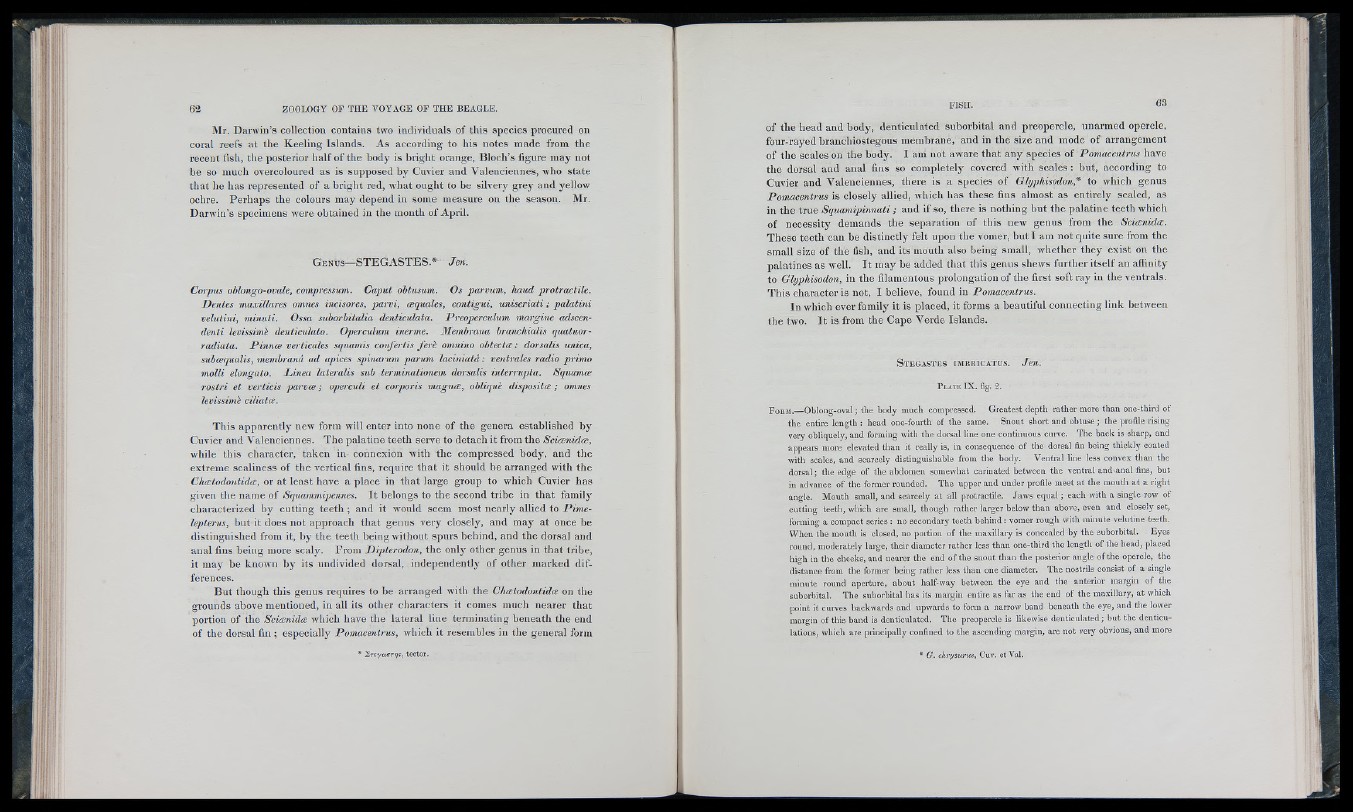
Ih
Mr. Darwin’s collection contains two individuals of this species procured on
coral reefs at the Keeling Islands. As according to his notes made from the
recent fish, the posterior half of the body is bright orange, Bloch’s figure may not
be so much overcoloured as is supposed by Cuvier and Valenciennes, who state
that he has represented of a bright red, what ought to be silvery grey and yellow
ochre. Perhaps the colours may depend in some measure on the season. Mr.
Darwin’s specimens were obtained in the month of April.
G e n u s—STEG A STE S.* Jen.
Corpus oblongo-ovale, compressum. C aput obtusum. Os parvuni, haud protractile.
D enies ma.vUlares omnes incisores, parvi, (Bquales, contigui, un iseria ti; p ala tini
velutini, m inuti. Ossa suborbitalia denticulata. Preoperculum -margine adscendenti
levissimh denticulato. Opercidum inerme. M em brana hranchialis quatuor-
radiata. P in n a verticales squamis confertis ferh omnino obtecta: dorsalis unica,
stibaqualis, membrand ad apices spinarum parxim laciniatd: ventrales radio prim o
m olli elongato. L in ea lateralis sub terminationem dorsalis interrupta. Squam a
rostri et verticis p a r v a ; operculi et corporis magnce, oblique d isp o sita ; omnes
levissimh ciliata.
This apparently new form will enter into none of the genera established by
Cuvier and Valenciennes. The palatine teeth serve to detach it from the S c ia n id a ,
while this character, taken in connexion with the compressed body, and the
extreme scaliness of the vertical fins, require that it should be arranged with the
C hatodontida, or at least have a place in that large group to which Cuvier has
given the name of Squammipennes. It belongs to the second tribe in that family
characterized by cutting teeth ; and it would seem most nearly allied to P im e-
lepterus, but it does not approach that genus very closely, and may at once be
distinguished from it, by the teeth being without spurs behind, and the dorsal and
anal fins being more scaly. From D ipterodon, the only other genus in that tribe,
it may be known by its undivided dorsal, independently of other marked differences.
B ut though this genus requires to be arranged with the Chcetodontida on the
grounds above mentioned, in all its other characters it comes much nearer that
portion of the S cia n id a which have the lateral line terminating beneath the end
of the dorsal fin ; especially P om acentrus, which it resembles in the general form
• l-rf/avTTjs, tector.
of the head and body, denticulated suborbital and preopercle, unarmed opercle,
four-rayed branchiostegous membrane, and in the size and mode of arrangement
of the scales on the body. I am not aware that any species of P om acentrus have
the dorsal and anal fins so completely covered with scales : but, according to
Cuvier and Valenciennes, there is a species of Glyphisodon,* to which genus
Pom acentrus is closely allied, which has these fins almost as entirely scaled, as
in the true Sqxiam ipinnati; and if so, there is nothing but the palatine teeth which
of necessity demands the separation of this new genus from the Scianid a.
These teeth can be distinctly felt upon the vomer, but I am not quite sure from the
small size of the fish, and its mouth also being small, whether they exist on the
palatines as well. It may be added that this genus shews further itself an affinity
to Glyphisodon, in the filamentous prolongation of the first soft ray in the ventrals.
This character is not, I believe, found in Pom acentrus.
In which ever family it is placed, it forms a beautiful connecting link between
the two. It is from the Cape Verde Islands.
S t e g a s t e s im b r ic a t u s . Jen.
F o r m .— Oblong-oval; the body much compressed. G reatest depth rather more than one-third of
the entire length : head one-fourth of the same. Snout short and obtuse; the profile rising
very obliquely, and forming with the dorsal line one continuous curve. The back is sharp, and
appears more elevated than it really is, in consequence of the dorsal fin being thickly coated
with scales, and scarcely distinguishable from the body. Ventral line less convex than the
dorsal; the edge of the abdomen somewhat carinated between the ventral and anal fins, but
in advance of the former rounded. The upper and under profile meet at the mouth a t a right
angle. M outh small, and scarcely at all protractile. Jaw s e q u a l; each with a single row of
cutting teeth, which are small, though rather larger below than above, even and closely set,
forming a compact series : no secondary teeth behind: vomer rough with minute velutine teeth.
When the mouth is closed, no portion of the maxillary is concealed by the suborbital. Fyes
round, moderately large, their diameter rather less than one-third the length of the head, placed
high in the cheeks, and nearer the end of the snout than the posterior angle of the opercle, the
distance from the former being rather less than one diameter. The nostnls consist of a single
minute round aperture, about half-way between the eye and the anterior margin of the
suborbital. The suborbital has its margin entire as far as the end of the maxillary, a t which
point it curves backwards and upw ards to form a narrow band beneath the eye, and the lower
margin of this band is denticulated. The preopercle is likewise denticulated ; but the denticulations,
which are principally confined to the ascending margin, are not very obvious, and more
* G. chrysuriis, C uv. etV al.